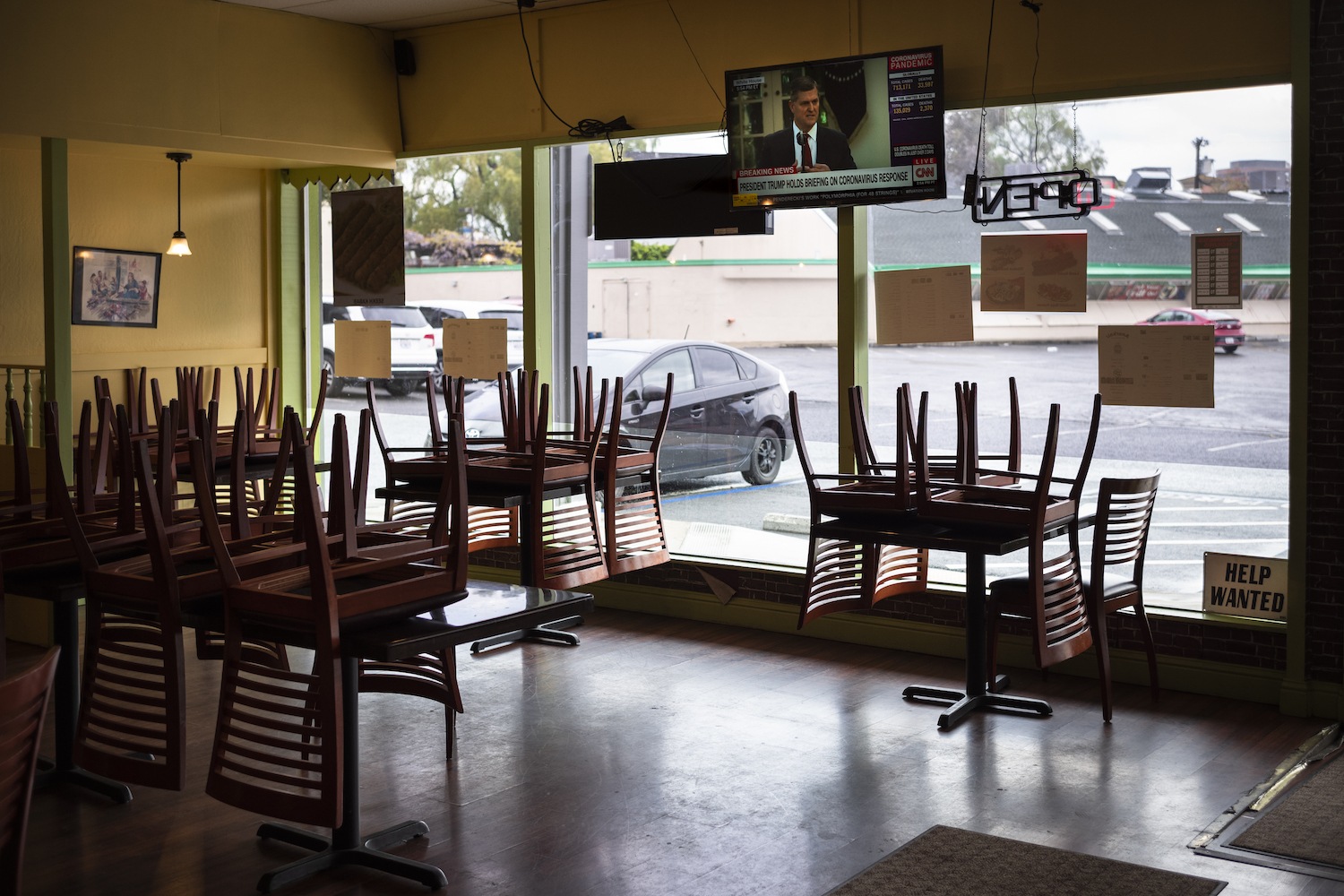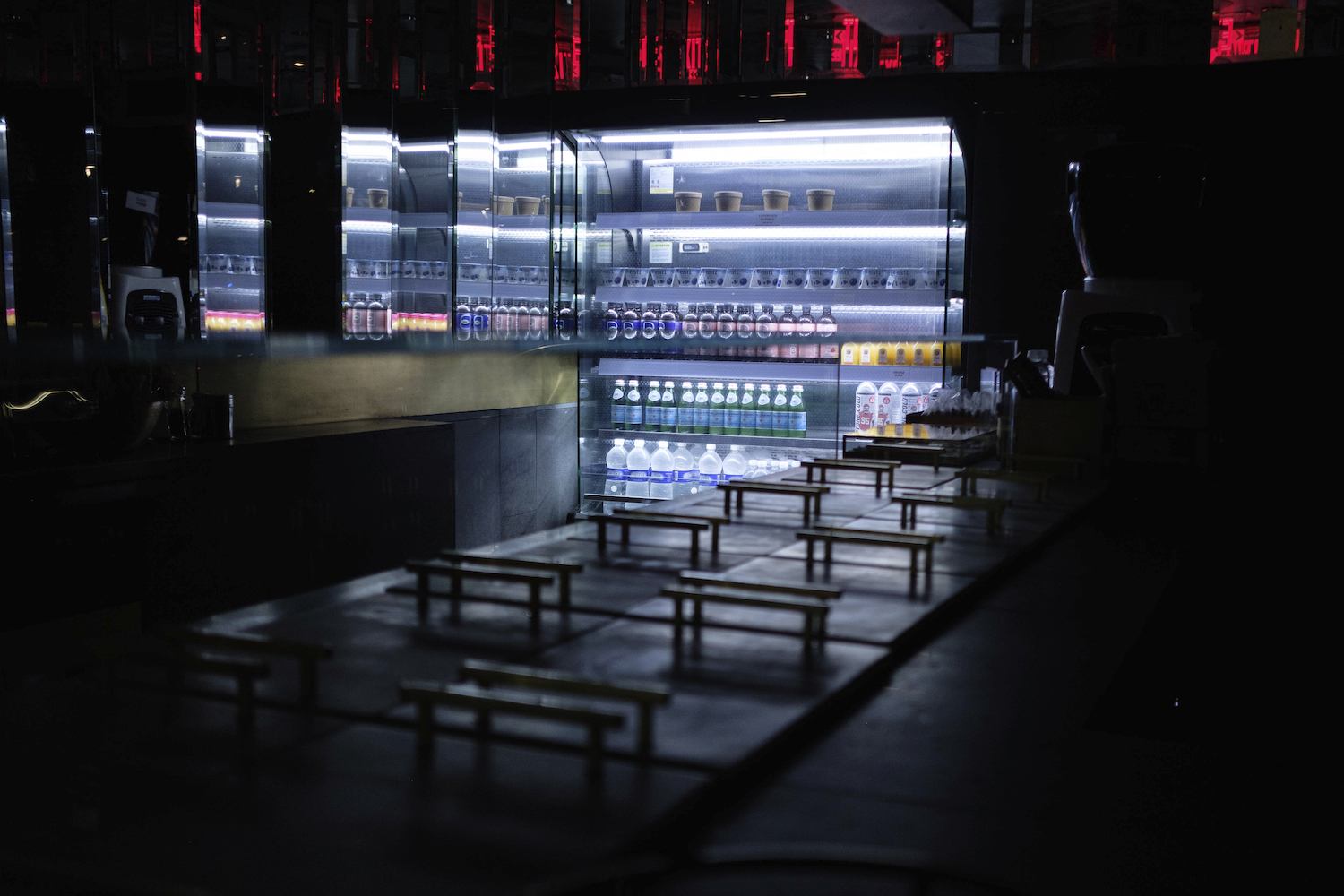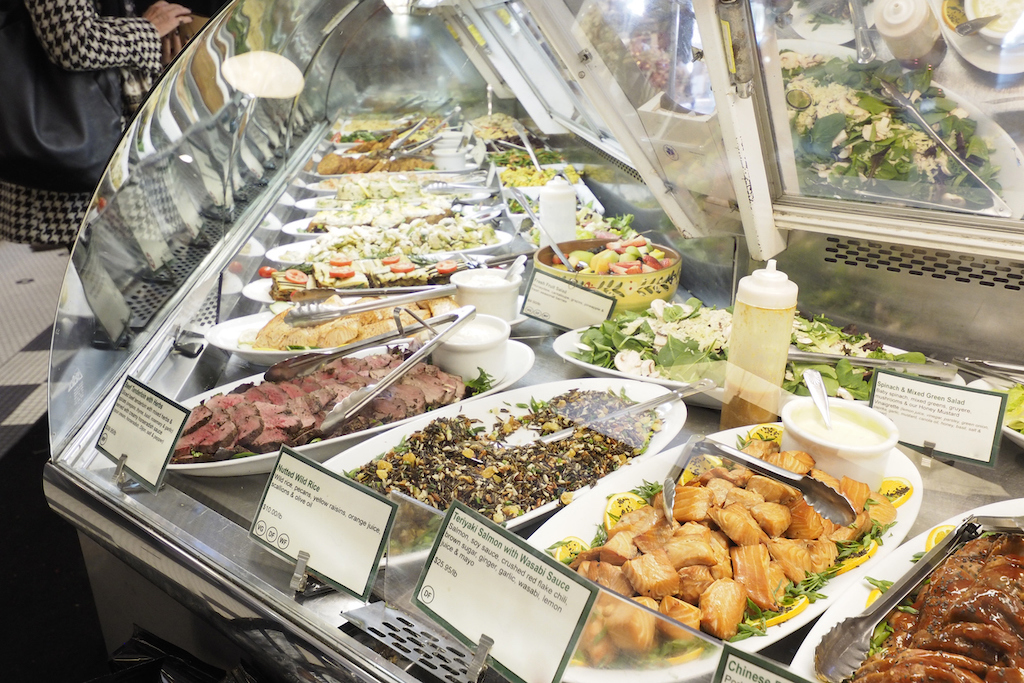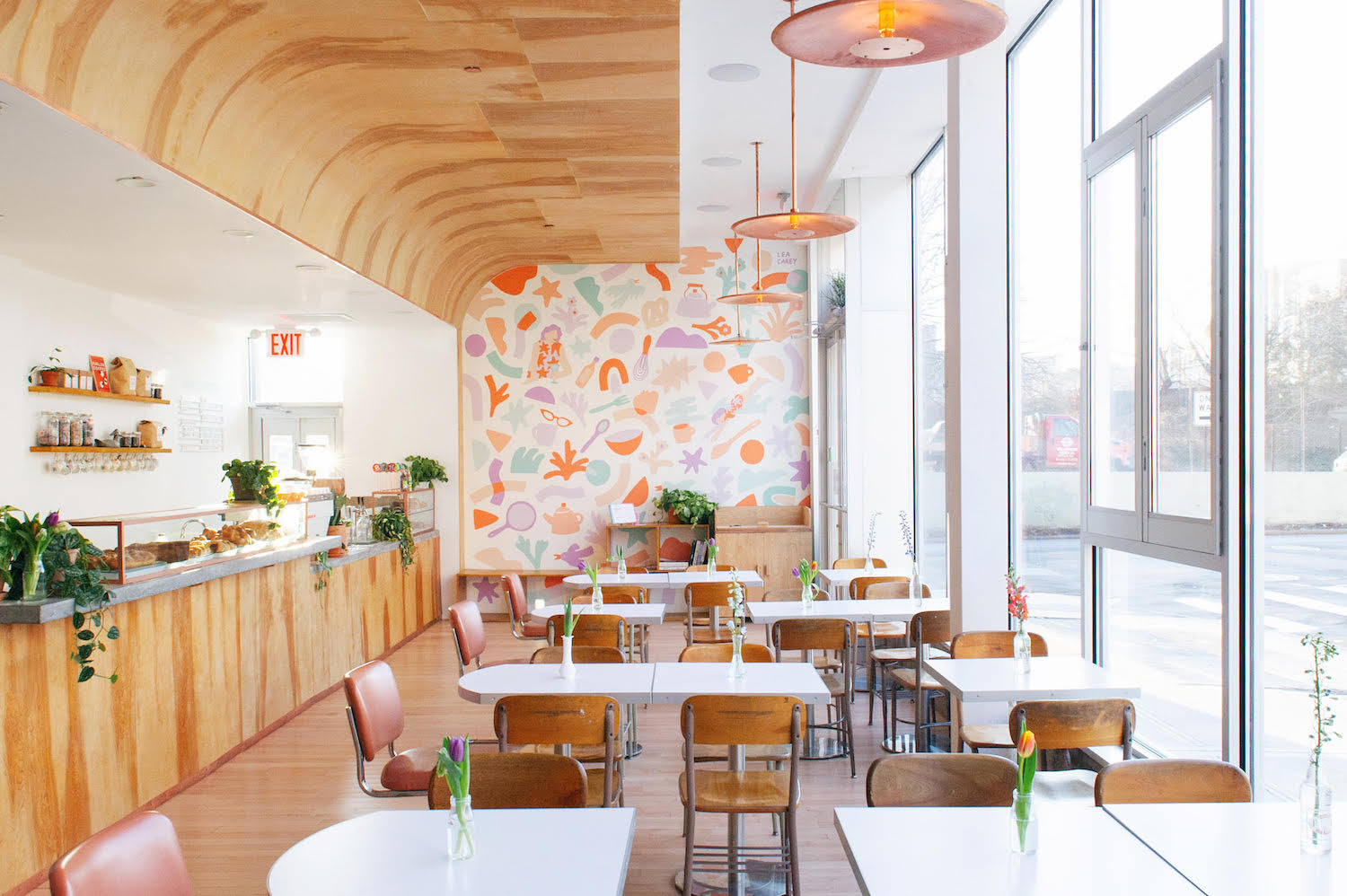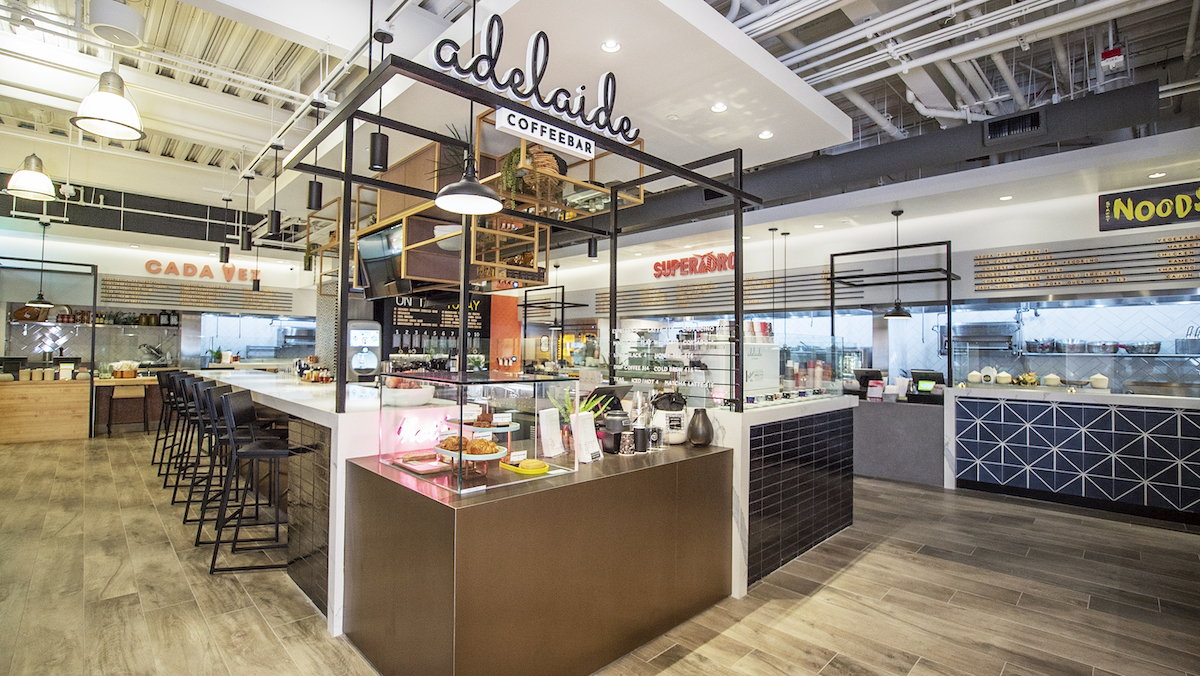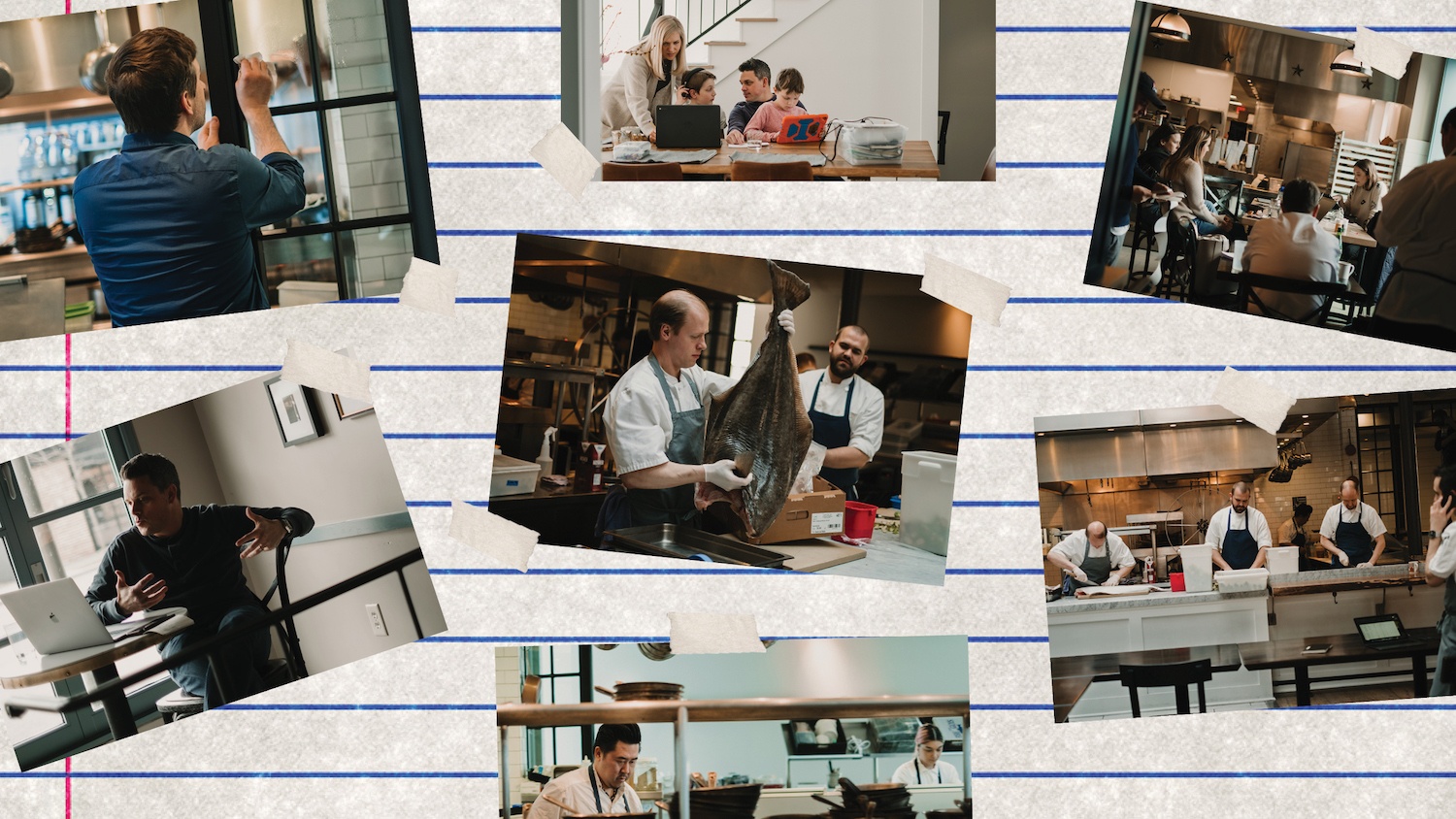
Skidmore, Owings and Merrill (SOM)
A stall costs less to open than a restaurant, and hungry landlords offer a menu of services that reduce the risk even further. Still, some restaurateurs caution the drawbacks are equally clear.
Akhtar Nawab has seven chef friends whose restaurants have gone out of business because of the Covid-19 pandemic, and yet he is headed from New York City to Chicago to see how a new 10,500-square foot project is going, ahead of its anticipated opening August 3.
Nawab has seen the future, and it doesn’t look like his friends’ defunct places, nor like his full-service restaurants in Brooklyn, New Orleans and Washington, D.C. It looks like a food hall: specifically, the Dr. Murphy’s Food Hall in the Cook County Hospital complex, which Nawab’s Hospitality HQ Group will operate in addition to Inner Rail Food Hall in Omaha, Nebraska; until July, he also operated a stall at Brooklyn’s Time Out Market.
Since March, restaurateurs who always stood on the brink of trouble have become more desperate to find ways to stay afloat—but so have developers, whose clothing-store mall anchors have fallen like so many dominoes. They’re ready to deal, to offer restaurateurs an unlikely refuge in the hope that food halls will lure customers back to retail centers and multi-use developments when they re-open.
Since March, restaurateurs who always stood on the brink of trouble have become more desperate to find ways to stay afloat—but so have developers, whose clothing-store mall anchors have fallen like so many dominoes.
“The power dynamic has flipped—the real estate industry needs the restaurant industry more than vice versa,” said Phil Colicchio, whose consulting group currently works on about 50 shopping center projects around the country. “Food and beverage are driving the bus.”
A 250-square-foot stall in a food hall is hardly the full-service, brick-and-mortar dream that for decades has inspired young chefs to go into debt, but it feels like a right-sized option to chefs who think that Covid has changed the restaurant landscape permanently. “We always had food halls in the plan,” said former restaurant pastry chef and James Beard nominee Dana Cree, whose small Chicago storefront, Pretty Cool Ice Cream, expanded last November to an 8-by-15-foot counter at Time Out Market, in the city’s restaurant-dense West Loop neighborhood.
A food hall’s allure is simple, at a moment when traditional restaurants are being whiplashed by closings, reduced-occupancy re-openings, second-wave closings and unyielding landlords: A stall costs less to open than a restaurant, and hungry landlords are offering a menu of services that reduce the risk even further.
The drawbacks are equally clear—no profitable liquor sales (the developer or operator usually handles that), limited menu, limited profit potential, and the risk of “diluting your brand,” said Nate Adler, the owner of Brooklyn’s Gertie restaurant, who briefly consulted on a food-hall project, just as briefly tried running a stall himself, and walked away, unconvinced. “If the food hall has a great operator, which is a huge ‘if,’ and it’s a very centrally located place with a critical mass of people in the neighborhood, then you could be in fine shape,” he said. “But it’s a microcosm of the most competitive environment you can imagine. You share a space with all your competition.”
Still, even a big “if” has its appeal, right now, whether food halls turn out to be a temporary solution or the face of dining to come.
The standard set-up involves a concession contract between the developer and the “vendor,” said Colicchio, usually one to three years, compared to restaurant leases, which are longer and harder to break. The developer builds out the space and the individual stalls, provides equipment and a point-of-sale system, covers utilities and trash collection, often pays for a marketing campaign—and for all that, instead of traditional rent, vendors pay a percentage of sales. The chef is responsible for food and labor costs, a far shorter to-do list than at a brick-and-mortar restaurant.
Food hall rent can run as high as 25 percent of gross revenues, a terrifying number to chefs who are used to the best-case restaurant budget figure of 10 percent, but Troy Guard, a chef/owner of multiple restaurants who’s about to become a food-hall entrepreneur, said that the figure isn’t as high as it sounds when all those perks are factored in. Guard is so convinced of food halls’ potential that he just bought a 13,000-square-foot space in Denver, a former brewery, which he’s transforming into Grange Hall, a food hall with 11 stalls, four of which he’ll operate himself.
He’s focused on a different 25 percent, “the profit that hopefully you can put in your pocket after paying an equal percentage on rent, food, and labor,” a bigger chunk than the standard brick-and-mortar 8 to 10 percent, though for a smaller venue. A restaurant in a healthy climate stands to bring in more, but today is hardly healthy, so a bigger percentage feels like a security blanket.
It’s a microcosm of the most competitive environment you can imagine. You share a space with all your competition.”
Adler preaches caution; while it’s a bigger percentage, “it’s a tiny pot. Think of how many falafels you have to sell to make any money. I’m not saying it can’t work. I’m saying many of them don’t work. The risk is definitely less, but the upside barely exists.”
Still, a wide range of chefs has started to think small: The successful chef, like Nawab, who can’t see running a full-service kitchen forever; “Top Chef” season seven winner Kevin Sbraga, who’s developed a food-hall concept after opening and closing five restaurants; Cree, who bumped up against the buttercream ceiling in restaurants, saw no path to promotion or ownership, and struck out on her own; and a young woman who came to Nawab with an all-day breakfast concept and no idea how to pull it off.
To them, the food hall is a practical alternative to restaurants, which were hardly in robust health six months ago, and are now punch-drunk Covid casualties, just waiting for the next blow. “There are a lot of people who’ve lost or are going to lose their positions and may not be able to get them back,” said Sbraga. “A food hall would enable them to get in with a low cost of entry, to see if something works. “The old model, of multiple full-service restaurants, was great, and served a purpose, but for someone like me, if I can have one concept and put it in multiple locations, that’s what I want to do.”
For Cree, a food hall was a low-maintenance way to address a chronic problem: how to get Chicagoans to eat ice cream in the dead of winter, when traffic dropped at her freestanding ice cream shop. “The captive audience was a big part of the decision,” she said. “We need people to go eat somewhere else and then come to us,” which is what happened until the virus hit. That and the developer’s services made it irresistible: “We arrived with our ice cream about seven days before we opened, did our staff training, learned the point of sale system, and that was that.”
The food hall is a practical alternative to restaurants, which were hardly in robust health six months ago, and are now punch-drunk Covid casualties, just waiting for the next blow.
As with any boom, there’s an element of buyer beware. Nawab says that the fee structure “can vary from place to place,” or even within a single company: Vendors paid more to be part of Time Out Market than they did in Omaha, and Omaha’s licensing arrangements are in the process of being adjusted to take Covid downtime, and rent abatements, into consideration. Refundable fee policies vary, as do consulting fees. Some operators prefer to license a concept and operate it themselves, which means a chef hands over an idea, and control, and hopes that strangers do a good job with the brand.
And not all halls are created equal. “If the hall’s already open, what does the foot traffic look like and what are the other products?”, said Sbraga, who had a short-lived stall at Purdue University’s Crave Food Hall and hopes to find a home at a Dallas hall for Sonny & Sons, his fried-chicken business. “You don’t want to bring class-A food into a class-B hall. If it’s not open yet, you have to ask about other vendors and competing venues, and you have to have language that you’re exclusive. You should be complementing the other vendors, not competing.”

Food halls can be a saving grace for some businesses that might not otherwise have the same level of foot traffic.
iStock/eyecrave
Whatever the deal structure, there’s one constant: no cap on the percentage rent, no cut-off of the landlord’s share, no matter how well a stall performs. Troy Guard knows of several stalls that bring in over $1 million in annual sales, with $250,000 going to the developer, but he’s philosophical; success isn’t a bad problem to have. And according to his breakdown, the vendor does just as well.
A popular stall can spawn offspring, whether that means more stalls, or someday, in a more stable future, a standalone restaurant. “That’s the cool thing behind this,” said Sbraga. “Let’s say you license for 24 months and you’re crushing it. There’s no reason you can’t go find a bigger space, or relocate elsewhere. A successful stall doesn’t guarantee you’ll be successful elsewhere, but it does give you the chance to build your brand, test it out, see how well it does.”
A popular stall can spawn offspring, whether that means more stalls, or someday, in a more stable future, a standalone restaurant.
If you don’t do well, a developer can vote you off the island, and fairly quickly. Guard said that his group can remove a vendor whose average sales over six months, or for 90 days straight, would yield less than $300,000 for the year, and that holds true for his stalls at Grange Hall as well as anyone else’s.
“It’s better that way,” he said. “If something’s not working, people can move on. If it’s one of my places I’d be bummed to be kicked out, but honestly, I didn’t put in money and get into this not to do well. Maybe it means I need to think about the concept.”
And failure’s relative. “If I were in a restaurant with 5,000 square feet and had to close, that’s a huge loss for me and for the landlord,” said Guard, “that’s six to 12 months to turn it around. With our model, we can get someone else in the stall quickly, and the whole food hall doesn’t have to stop working while we do.”
—
It’s all theoretical at the moment, since the halls haven’t re-opened, but the momentum’s there: While existing restaurants run numbers to see how long they can survive on reduced occupancy, food halls are exploiting a floorplan that could be more conducive to careful re-entry.
While existing restaurants run numbers to see how long they can survive on reduced occupancy, food halls are exploiting a floor plan that could be more conducive to careful re-entry.
“The thing about food halls is, there’s a much larger footprint than in a restaurant,” said Nawab, “so we can create a floorplan that allows for the right layout. We’re double or triple the size of a large restaurant. We could seat 340, so right now we can still seat 160, while a big restaurant might seat 200 and now is down to 100. We can think creatively about how best to serve people, to make it an easy experience—we’re developing a new point-of-sale platform, for example, so that everything comes to a single kiosk, whether you’re ordering takeout, delivery, or to eat here.”
In a nod to lingering pandemic habits, there will be contactless pick-up: A customer can pre-order, pay, and pick up food at a designated outdoor area.
Adler’s skeptical. “More power to you if you can figure it out, and everyone’s trying to innovate,” he said, “but I wouldn’t go to a food hall right now because of the lines. And as an operator, at least in my own place I can control my own environment. In a food hall I can’t control employees from 10 other businesses, and what if we have to share a dish pit?”
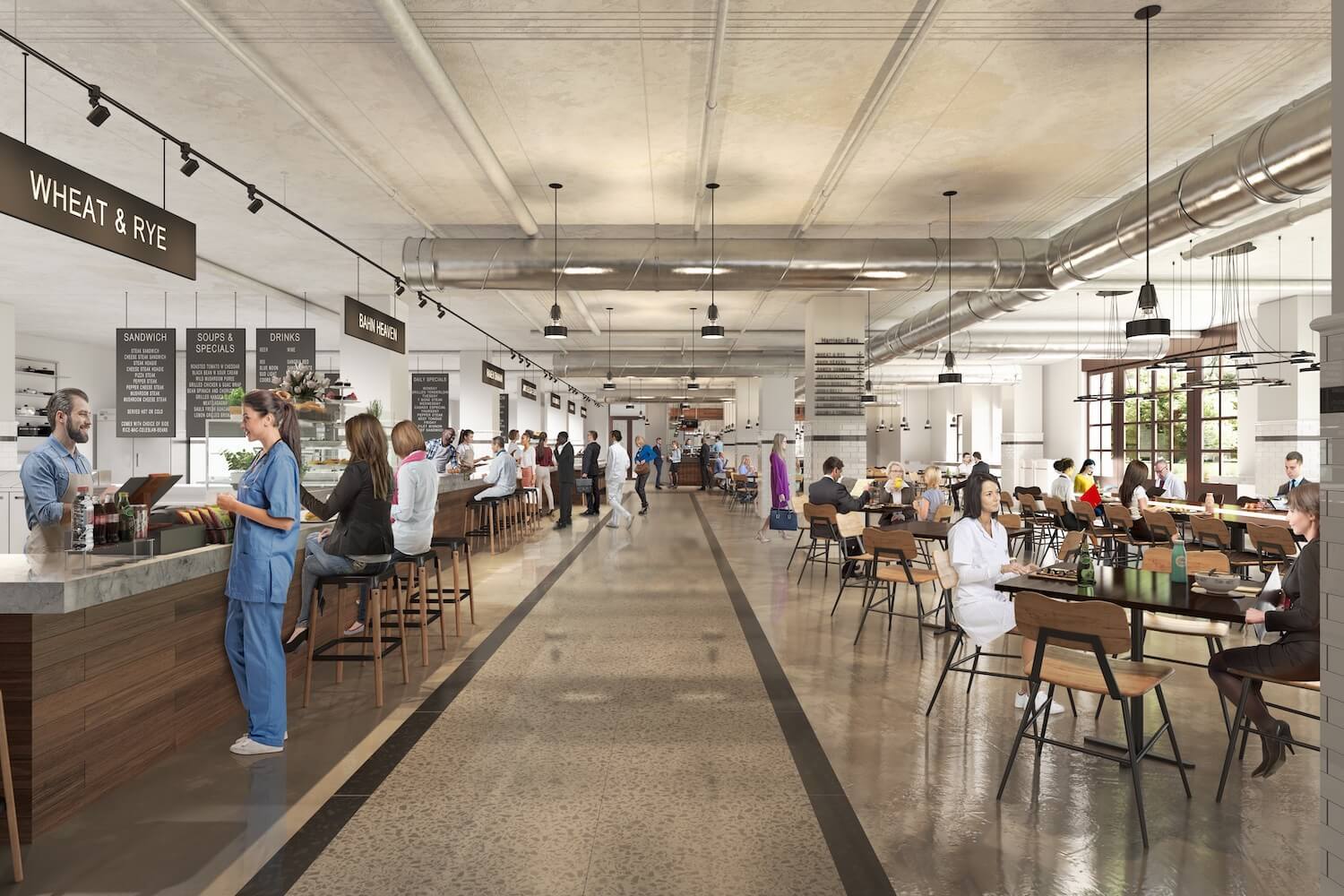
Plans for Dr. Murphy’s Food Hall in Chicago, Il, set to open this summer.
Skidmore, Owings and Merrill (SOM)
To Nawab, it’s all a matter of process; the opening of the Dr. Murphy’s hall was delayed from June to August in part to address issues of design and safety.
And hall proponents point out that full-service restaurants don’t feel like a viable option; that they were already a dying breed, as millennial and Gen Z customers embraced quality fast-casual food and showed little interest in the trappings of full-service fine dining.
Once restaurants had to shut down—twice, for a growing number, many permanently—out-of-work cooks looked for a more nimble way to satisfy those customers. “What’s going to come out of the reshaping of our industry,” said Cree, “is that more people in the industry are going to step away from restaurants and step into artisan food products. That’s how they’re getting by right now—one of my friends is home baking cookies for pre-order and pick-up. People are getting passionate about making pickles, or sauces, and that’s how they express their love of food to other people, through small-batch items they might advertise on Instagram.”
And Guard is blunt: food halls are cheaper, at a time when customers might be looking for diversion but have less money to spend on it. “Once unemployment runs out,” he said, “people are going to be watching their dollar bills. A food hall is a feasible place to have a good time for a reasonable price.”
“Once unemployment runs out, people are going to be watching their dollar bills. A food hall is a feasible place to have a good time for a reasonable price.”
In Cree’s vision of the future, the type of restaurant she used to work at still exists, but there are fewer of them, and they are more of a special-event destination, less the kind of place you drop into twice a week for a favorite dish. There’s no way to tell yet, though, as others dig in and hope that a redesign, or a pantry or meal-kit program, will shore up their existing restaurants.
But Colicchio, who teaches a class called “Legal and real estate strategies for the restaurateur” as part of the Culinary Institute of American’s online master’s program in professional studies, recently advised his students to abandon a plan he had laid out for them mere months earlier. Before Covid hit, he had walked the class through the usual scenario for opening a restaurant, which involved debt, more debt, and leaning on friends and family for money. The term ended in March, as the virus took over the headlines, giving him just enough time to contradict himself.
“I walked in and said, Throw out everything I told you,” he said. “If I were opening an independent restaurant, I used to begin with $50,000 I saved, then maybe dad dropped in $25,000, cousin Freddie loaned me $25,000. That’s gone for the foreseeable future. Who has access to capital? Real estate groups, and they have to start using it differently: think of a restaurant as a desirable amenity for them, that, if operated well, will have a halo effect, draw more people in, make some profit.”
“The anvil is falling on restaurants,” he said. “But the rebuild is squarely on the shoulders of the real estate industry.”

